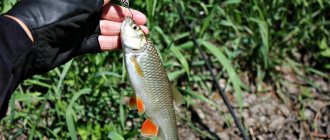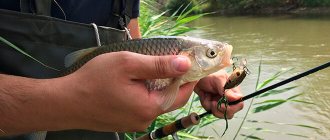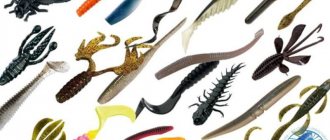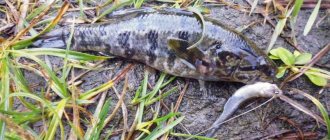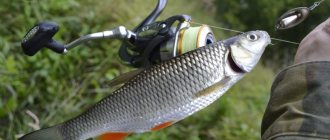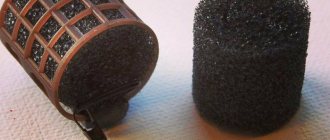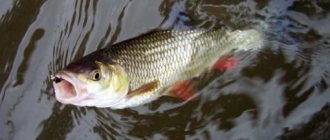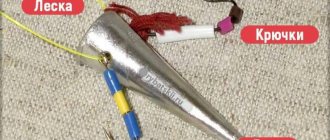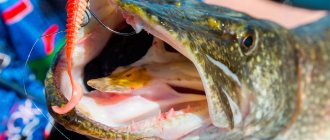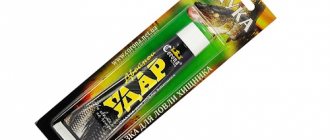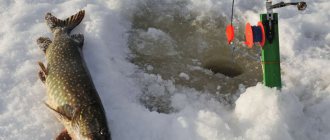Over the years, wobblers have become the most popular bait for catching chub. On the Internet you can find more than one rating of the best “chub” wobblers, because wobblers in most cases turn out to be more catchy for chub.
But in some situations, good old spinners (both spinners and spinners) show results no worse, or even superior, to wobblers.
This article is dedicated to spinners and spinners, and about wobblers, read the separate article “wobblers for chub”, where you will find a lot of useful tips, photographs and a rating of the best wobblers for chub.
Spoons for chub
Small oscillating spoons, as practice shows, catch chub quite well. Such baits are especially good for fishing in the autumn, in September-October.
Spinner spoons used for catching chub are in most cases equipped with single hooks.
In this regard, they are less prone to getting caught on aquatic vegetation, tree branches and other obstacles under water.
It is also worth noting that due to the manufacture of metal spinners, these baits fly with greater accuracy, which is a significant plus when fishing in windy weather.
How to make your own bait
Today, fishing stores offer a wide range of baits. You can purchase them for different gear and types of fishing. But some fishermen prefer to make them themselves. For many, this activity brings the same pleasure as fishing itself.
Artificial
To make artificial bait, you need to use available materials and tools, and also read step-by-step instructions. The wobbler can be made of wood or plastic.
Bait is made from wood as follows:
Source
Overview of chub spinners
Miniature models such as Nories Boon (1.5 g), Nories Weepper (2.1 g) and SV Fishing Lures Individ have proven themselves to be excellent chub baits.
Of the large spinners, Mepps Cyclop stood out.
The Smitt Pure spinner came to us from Japan and has already received the status of a classic bait. I didn’t get it out of nowhere, because the spinnerfish is actually very catchy, and it catches not only chub, but also perch, asp, ide and even such peaceful fish as bleak, roach and bream.
Related article: choosing the color of the spinner
Turntables for chub
Rotating spinners stand apart. First of all, small and medium-sized spinners will be an excellent option for chub baits for beginning spinners.
However, we note that rotating spoons are not very good when catching a passive predator.
There are no fundamental differences among the entire variety of spinners, and therefore there should not be any particular difficulties in choosing spinners of this type.
In your fishing arsenal you should always keep at least 7-10 spinners of different sizes that will work at minimum fishing speeds.
Mepps Aglia Long is probably already familiar to many fishermen from all countries of the post-Soviet space. Works well in different environmental conditions; The range includes models with natural or acid paint.
Mepps Aglia is another suitable spinner, characterized by its simplicity, affordable cost and at the same time good catchability. It works best when fishing close to the shore with a weak current.
The Myran Agat spinner cannot be called very catchy, but from time to time it brings good results. Preference should be given to baits weighing 3 or 5 g.
The Blue Fox Super Vibrax spinner also does not claim first place in the ratings, but has long established itself as a proven average.
Spinner spinners cannot be called very catchy and common baits for chub, but when wobblers and spoons do not justify themselves, spinners can literally save you from a “distressed” situation and bring at least a small catch.
Spinners
This type of bait is as good as the previous type. The leader in the production of spinners of the required size and weight for catching chub is Mepps.
The optimal weight of spinners is from 5 to 15 grams, since large models in strong currents will create strong resistance, which will interfere with comfortable fishing. Spoons with a silver petal perform best, but black colors are worse.
When to use:
In summer in clear sunny weather. The wiring should be carried out uniformly and superficially (at a depth of no more than half a meter).
Where to use:
On rivers with medium flow and little vegetation.
As for the specific sizes of spinners, in the context of individual types of petals, I adhere to the following proportions: Comet No. 1 and 2; XD Nos. 1 and 2; Aglia No. 0-2; Aglia Long No. 0-I+; Lusox No. 0; Thunder Bug (by the way, actually works reasonably well in the current) No. 0-2.
In spinning, in each of its branches, by which I mean a focused attitude towards catching fish of one species, there is an unspoken “gentleman’s set” of baits, the composition of which, as a rule, depends on local specifics. But these sets certainly contain lures that are basic for every angler’s arsenal, regardless of geographic latitude and longitude. For example, for those who like to catch pike, use the oscillating spinner “Storling”, asp – “Kastmaster”, catfish – a heavy jig or wobbler.
But for the chub? It seems like, according to the good old Soviet books, the combination “chub - rotating spoon” can be traced. But recently, “chub – mini-wobbler”, “chub – ultra-light jig” or “chub – combined bait” have become increasingly common. This begs a logical question: what is the basic bait for chub today, which most practitioners nod their heads in approval when they hear about it? For myself, I found the answer - as before, it is a rotating spoon.
b) they are quite universal; c) have intense “game”; d) they are not demanding on wiring, which is important in conditions cramped by snags and algae. I note, however, that this only applies to “rolling” chub fishing, i.e. in sections of rivers with moderately fast currents and background depths of 0.5-2 m, as well as about fishing in small rivers.
Requirements for the spinner We will talk here not so much about the requirements for the bait from the spinning angler, but from the chub. So, the “chub ultimatum” looks like this.
3. The bait should not frighten the fish with excessive noise when casting, large size, etc.
Color
Needless to say, rolling fishing is very demanding on the weather. It goes without saying that there is sun or, at a minimum, no rain. According to that theory, “silver”, as the brightest, and therefore “cloudy” color, falls out of the holder. As a result of my fishing experience, I formed a different point of view: everything is the same, only exactly the opposite. The maximum number of bites occurred on silver petals, “gold” was in second place, but “copper” and variations on the Black Fury theme did not live up to my hopes.
“Fly” on a spinner - pros and cons
Petal shape (mepps scale)
As for the small river, the Comet also takes the lead here; the front-loaded Lusox also performed well. By the way, if you strictly adhere to the theory, it becomes unclear why the reputable company Mepps developed the shape of the Thunder Bug petal? In terms of size and design, it seems to be just what we need for our fishing, but, excuse me, a chub in still water is rather an exception, and theoretically, there’s not much to do in the current with such a wide blade.
As for the specific sizes of spinners, in the context of individual types of petals, I adhere to the following proportions: Comet No. 1 and 2; XD Nos. 1 and 2; Aglia No. 0-2; Aglia Long No. 0-I+; Lusox No. 0; Thunder Bug (by the way, actually works reasonably well in the current) No. 0-2.
[THERE IS AN ANSWER] How to tie a spinner to a fishing line
Decoration By “decoration” I mean the combination of the petal’s own metallic color (core) and the color of the pattern applied to it. Whenever you come across all sorts of decorations, there are painted insects and scales. I am of the opinion that a fish is a rather reflexive creature, which is not always able to appreciate the “art” offered to it. Therefore, healthy skepticism will not hurt here.
The following color combinations have proven themselves to be quite good: - “gold” + red, blue, black; — “silver” + red, blue; - “copper” + red; — black + light green, yellow.
In addition, undecorated ones also worked stably, i.e. devoid of streaks and stripes, but purely “golden” and “silver” petals. Sometimes the “trout decoration” worked. But the chub did not like the aggressive shine of the stickers - such as flexolite. Regardless of the color, the best impression was left by simple drawings in the form of ordinary dots on the petal.
Front loading or rear loading?
Objectively, I catch more with classic spinners with rear loading. There are many reasons for this: firstly, it is very difficult to find a high-quality unloaded chub-size spoon, and secondly, according to practice, catchy fishing is simple: it all comes down to the “throw and reel” scheme - no “steps”, no jerks .
About the petal shape
The speed of its rotation directly depends on the shape of the petal. The narrower the petal, the faster and with less resistance the wiring occurs. As a result, the spinner becomes very “fast”. And vice versa - wide rounded petals are more stubborn and slow - and their rotation speed is lower.
The chub preferred the Comet to all other options, hence the conclusion: for such fishing, moderately slow “spinners” with average drag, i.e. a kind of “golden mean” that has “immunity” against the current - and, at the same time, a rather powerful hydroacoustic wave inherent in “lake” petals. In general, what to give the chubs to choose from is a very complicated question. And there is no need to expect a definite answer here.
In-Line - for the trophy
As you know, the chub is one of the most numerous white predators of the Don. Small, weighing up to four hundred grams, the chub stays in the river in schools. It loves fast currents, hunts on sandy and rocky rifts, stands on the border of fast and slow currents, in breakers and whirlpools, behind small stones, and waits for insects under overhanging branches of bushes. Larger specimens should be looked for deeper, near the bottom.
When my two comrades decided to hunt chub with a spinning rod for the first time, we were completely unprepared for such fishing. None of us had caught chub with a spinning rod before. Armed with an arsenal of spinners that work great for perch, and a couple of small wobblers. We arrived at the place recommended to us. It was a sandy and pebble section of the river with riffles, ripples, and bushes hanging over the water along the steep bank - the native places of the Don chub.
From early morning until noon, we persistently plowed the water with various spinners and mini wobblers. By lunchtime, only four small chubs were floundering in our cage. Two were caught on a Comet No. 2 spinner, one on a small Salmo Hornet wobbler, one on an Aglia No. 3 spinner (my first).
Panther Martin spinners, designed for trout fishing in fast mountain rivers in Italy, belong to a class called “In-Line”. which loosely translated means “on the axis.” Similar turntables are produced by several companies. The most famous models: MeppsXD. Vibric Rooster Tail, DAM Spuro Witch and, of course, Panther Martin.
It is worth paying special attention to the shape of the axial load. As a rule, it is drop-shaped. The weight is mounted with the thick part to the hook. Such a load, as well as the deflection of the blade in flight back towards the fishing line, ensures a longer and more accurate cast than with the same dimensions and weight. In addition, on classic Panther Martin models, the weight is made of soft metal, which reduces the sound of the lure hitting the rocks and does not spook wary fish.
In-Line - for the trophy
All of the above advantages of In-Line class spinners ensure successful hunting for large trophy chub. Long casting allows you to reach a predator standing at a considerable distance from the angler. The accuracy of casting ensures that the bait is supplied under the branches of bushes, to the tops of stones and snags protruding from the water. The uninterrupted operation of the petal makes it possible to fish with the current, moving baits using the “upstream” method.
Therefore, beginners who have recently begun to master fishing should stock up on lures of different colors.
